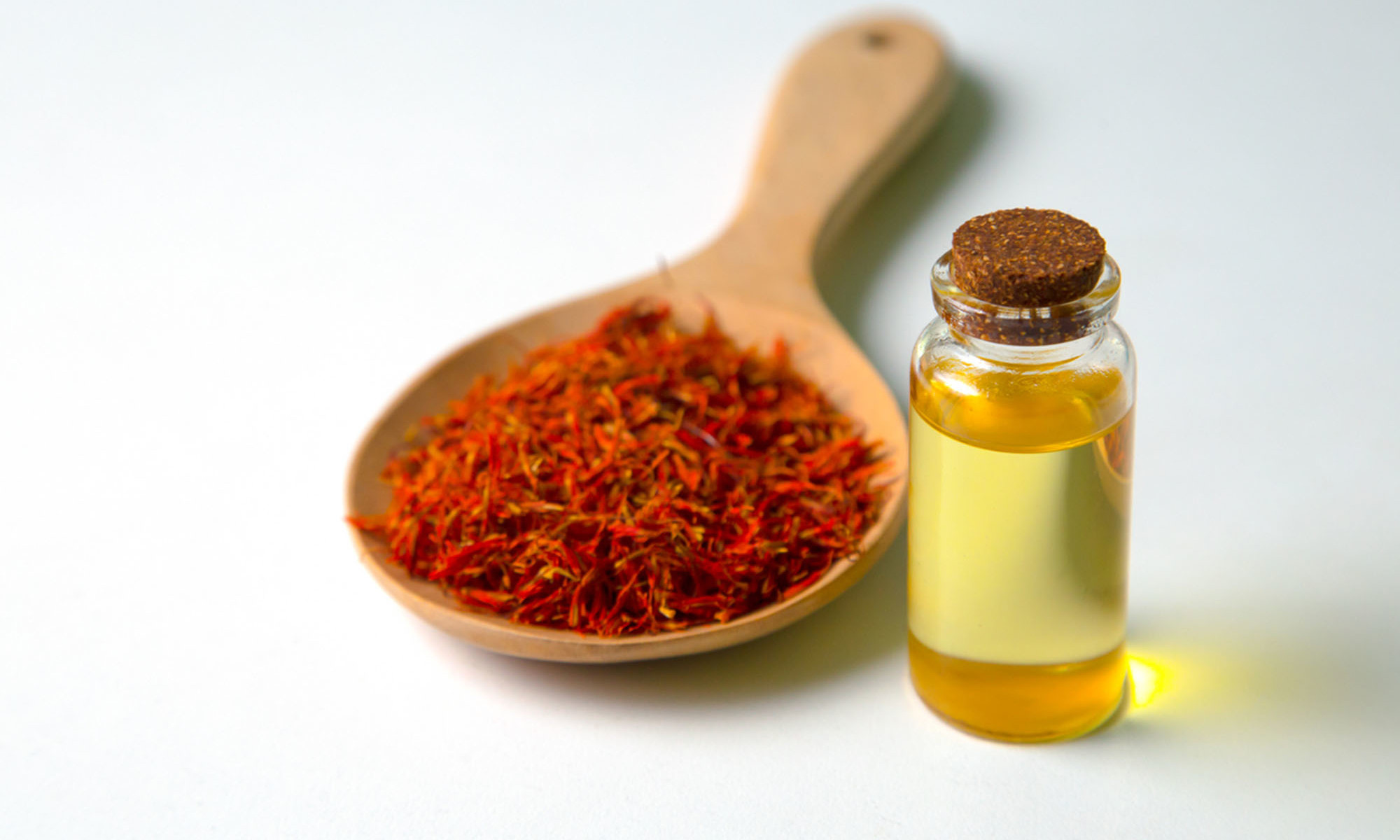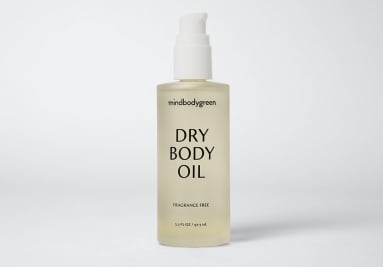Health Experts Want You To Ditch This Cooking Oil & Use It For Skincare Instead
A deep dive into safflower oil.


mbg Contributor
Megan Falk is an experienced health and wellness journalist. Megan is a graduate of Syracuse University's S.I. Newhouse School of Public Communications with a bachelor's degree in Magazine Journalism and a minor in Food Studies. She's also a certified personal trainer through the American Council on Exercise.

Expert review by
Lauren Torrisi-Gorra, M.S., RD
Registered Dietitian
Lauren Torrisi-Gorra is a Registered Dietitian with a Grand Diplôme in Culinary Arts from the French Culinary Institute and a bachelor’s in Communication and Media Studies from Fordham University. After a decade working in the culinary and media worlds, Lauren pursued her ultimate passion and received her master's degree in Clinical Nutrition and Dietetics at New York University.
Image by rujipong peamsirichok / iStock March 29, 2023 Our editors have independently chosen the products listed on this page. If you purchase something mentioned in this article, we may Take a peek at the nutrition panel on a bottle of dressing, bag of chips, or container of pre-popped popcorn, and there’s a chance you’ll see safflower oil listed in the ingredients section. The oil is a staple ingredient in processed foods and is ideal for high-temperature cooking, but how does its nutritional profile stack up against other popular cooking oils? Ahead, learn all about safflower oil—from key nutrients to environmental impact—according to experts and the latest research.
Advertisement
This ad is displayed using third party content and we do not control its accessibility features.
What is safflower oil?
Safflower oil is a vegetable oil derived from the seeds of the safflower plant, a member of the sunflower family1.
The flower thrives in arid climates2, such as those found in South Asia, China, India, Iran, and Egypt, and has long been used3 for medicinal purposes, including the treatment of menstrual pain and dysfunction, postpartum abdominal pain, and joint pain. Safflower oil in particular has been used2 in some areas of Asia and Africa to ease fevers, as well as in China, Japan, and Korea to improve4 skin and hair health.
Outside of medicinal purposes, safflower oil is also used as a cooking oil, thanks to its high smoke point of 450 degrees Fahrenheit, says Michelle Shapiro, R.D., a functional registered dietitian.
“Safflower oil, specifically high-oleic safflower oil, has a higher smoke point than other commonly used vegetable oils and is used for frying, sauteing, and other methods that may require high heat,” she notes. “It can be heated to high temperatures without breaking down and releasing harmful compounds."
Since safflower oil is also nearly flavorless, it’s commonly used in processed foods, including baked goods, chips, popcorn, margarine, salad dressings, mayonnaise, and snack bars, she says.
To extract safflower oil from the plant’s seeds, processors may use chemical solvents (such as hexane) or supercritical carbon dioxide5 (aka high-pressure CO2), says Shapiro.
Mechanical extraction methods are also used: In the cold-pressing process, safflower seeds are crushed and pressed, then the oil is extracted at a low temperature to maintain its nutritional value, she notes. The expeller-pressing process is similar, but the oil is extracted at a higher temperature, she says.
There is also some safflower oil that is extracted using both chemical and mechanical processes.
After extraction, safflower oil is often refined to remove free fatty acids that can impact taste, waxes, and other natural compounds; bleached to reduce colored pigments; and deodorized to fully eliminate those free fatty acids and odors, research shows6. “This is done to create a consistent, shelf-stable, neutral-flavor product,” says Shapiro.
Summary
Safflower oil is derived from the safflower plant, a member of the sunflower family. It has a history of medicinal uses in the Middle East, Asia and Africa, and has been used to treat joint pain, menstrual dysfunction, and more. Now frequently used in processed foods, safflower oil has a high smoke point and neutral flavor profile.
Advertisement
This ad is displayed using third party content and we do not control its accessibility features.
Nutritional value
Here's the nutritional breakdown of 1 tablespoon of safflower oil, according to the USDA7:
Advertisement
This ad is displayed using third party content and we do not control its accessibility features.
Though it depends on the batch, safflower oil usually contains low levels of saturated fat. Saturated fat can increase levels of low-density lipoprotein (aka LDL, or "bad") cholesterol and raise the risk for heart disease and stroke8 when consumed in excess. The oil also contains high amounts of unsaturated fats, which can reduce the risk of cardiovascular disease9 when consumed in place of saturated fat.
On average, safflower oil contains about 16 to 20% monounsaturated fatty acids (in the form of oleic acid) and 71 to 75% polyunsaturated fatty acids (in the form of linoleic acid), according to research10 published in Metabolites. However, the exact ratio of monounsaturated to polyunsaturated fatty acids can vary, depending on the specific type of oil, says Shapiro.
Polyunsaturated fats can be divided into two categories: omega-3 fatty acids and omega-6 fatty acids, says Shapiro. “[Both] omega-3 and omega-6 fatty acids must be consumed in the diet, but it is important that they are consumed in a balanced ratio,” she explains. “In safflower oil, there are negligible amounts of anti-inflammatory omega-3 fats, [and] most of the polyunsaturated fatty acids in safflower oil are omega-6 fats.”
When eaten in excess and without a balance of omega-3 fatty acids, omega-6 fatty acids can increase pro-inflammatory markers in the body11, she adds.
Summary
Low in saturated fat, safflower oil contains polyunsaturated fatty acids with the majority being omega-6s. It is important to consider how much and which types of polyunsaturated fats you are consuming, as the standard diet is high in omega-6s and there should be a better balance of anti-inflammatory omega-3s in our food.
Different forms of safflower oil
Wander through the cooking oil aisle of the grocery store, and you might come across the following varieties of safflower oil, each of which has unique properties.
Advertisement
This ad is displayed using third party content and we do not control its accessibility features.
Health benefits of safflower oil
1.
It may improve heart health in moderation.
Thanks to its low saturated fat and high unsaturated fat contents, safflower oil may improve heart health when consumed in moderation. In fact, reducing saturated fat intake and consuming polyunsaturated vegetable oil instead has been found to reduce the risk of cardiovascular disease by roughly 30%, research shows13.
What’s more, “monounsaturated fatty acids can help reduce LDL cholesterol levels in the blood, improve insulin sensitivity, and reduce inflammation in the body,” says Shapiro.
Research backs up this potential benefit of safflower oil, too. In a 2022 study14 of 67 individuals with metabolic syndrome (a combination of conditions that raise the risk of coronary heart disease, diabetes, or stroke), the participants who consumed 8 grams of safflower oil daily for 12 weeks—without changing their diet or physical activity—showed a significant reduction in systolic blood pressure and insulin resistance.
Advertisement
This ad is displayed using third party content and we do not control its accessibility features.
2.
It’s rich in vitamin E.
3.
It may support healthy skin.
With its moisturizing4 and anti-inflammatory16 properties, safflower oil can be a beneficial addition to skincare routines according to early research, says Marisa Garshick, M.D., F.A.A.D., a board-certified dermatologist based in New York City. The oil’s linoleic acid may help treat breakouts, making it a particularly useful ingredient for individuals with acne-prone skin, she notes.
In addition, the oil is rich in antioxidants that can support wound healing, says Garshick. In a 2020 study3, researchers found that safflower oil’s antioxidants demonstrated both antibacterial and antifungal effects, making it a suitable option to manage skin wounds and potential infections.
To top it off, safflower oil may prevent UVB ray-induced photoaging and, in turn, the development of wrinkles, according to 2020 research4.
The downsides of safflower oil.
Although safflower oil has the potential to improve your heart health and skin, it also comes with a few health and environmental concerns. Here are the potential drawbacks of safflower oil:
1.
It’s high in omega-6 fatty acids.
The omega-6 fatty acids found in safflower oil aren’t inherently harmful to health. In fact, they serve as17 important structural components of cell membranes and provide energy. But it’s important to keep your consumption of omega-6s balanced with omega-3 fatty acids.
“High omega-6 fatty acid intake can increase pro-inflammatory markers in the body when consumed in excess,” says Shapiro. And most people eating a typical Western diet are consuming too many foods rich in pro-inflammatory omega-6 fats, and not enough sources of anti-inflammatory omega-3 fats, she adds.
Over time, consuming excess amounts of omega-6 fatty acids while skimping on omega-3s may contribute to the development18 of chronic diseases, such as cardiovascular disease and cancer, says Shapiro.
2.
It contains saturated fat.
Although safflower oil is relatively low in saturated fat compared to other cooking oils, it could be potentially harmful when consumed in excess.
Reminder: Consuming too much saturated fat may lead to a build-up of cholesterol in the arteries, decreasing blood flow19 to the heart, brain, and kidneys, and can raise LDL cholesterol levels, increasing the risk of heart disease and stroke, according to the National Library of Medicine.
To prevent these health concerns, the USDA recommends limiting saturated fat intake to 10% of calories per day, or about 22 grams for a person following a 2,000-calorie diet.
3.
It generally requires chemical herbicides to grow.
In the United States, safflower plants struggle to compete with weeds, particularly when they're in the rosette stage and before the stems elongate. Interference from weeds throughout the growing season can reduce safflower grain yields by 93%, so a weed control program, such as the use of herbicides, is necessary.
Some herbicides approved for use with safflower—including glyphosate—may harm the environment.
A recent assessment by the U.S. Environmental Protection Agency20 suggests that glyphosate poses potential ecological risks to terrestrial and aquatic plants, mammals, and birds, and the risk for bees is currently uncertain. Glyphosate tends to accumulate in topsoil21 and, due to surface runoff, soil drift, and other natural processes, may enter groundwater and surface water.
For these reasons, you should opt for organic safflower oil in your food and beauty products when possible.
So, is safflower oil healthy?
Safflower oil contains hearty-healthy unsaturated fatty acids and antioxidants that support the immune system and fend off harmful free radicals. High-linoleic safflower oil, in particular, is rich in plant-based monounsaturated fats that may lower the risk22 of coronary heart disease when eaten in place of saturated fats. Safflower oil can also be a useful addition to your skincare routine.
However, the oil does contain high levels of omega-6 fatty acids. Since the standard American diet already includes high amounts of the polyunsaturated fatty acid, you may be best off choosing an oil that’s rich in monounsaturated fatty acids and boasts slightly higher levels of omega-3s, such as olive oil or avocado oil. Highly processed foods that contain safflower oil, like chips or sugary dressings, are also best avoided.
Summary
While safflower oil is a solid pick for skincare, its high omega-6-to-omega-3 ratio means it's not the healthiest choice for cooking. Opt for olive oil or avocado oil instead when you can.
Safflower oil vs. other oils.
Safflower oil vs. Sunflower oil
Both sunflower oil and safflower oil provide23 14 grams of fat per tablespoon, though the former contains slightly more saturated fat (1.44 grams) and monounsaturated fat (2.73 grams) and a bit less polyunsaturated fat (9.2 grams). The two oils also have a smoke point of 450 degrees Fahrenheit. So in the safflower oil vs. sunflower oil debate, there’s no clear winner; both of their nutritional profiles and use cases are relatively comparable.
Safflower oil vs. Avocado oil
A tablespoon of this fruit-derived oil offers24 14 grams of fat—just like safflower oil—and is rich in monounsaturated fat (9.88 grams) and low in polyunsaturated fat (1.89 grams). Avocado oil does contain a bit more saturated fat (1.62 grams) than safflower oil.
“Avocado oil is unrefined and has a higher smoke point [520°F] compared to olive oil, making it more suitable for cooking at higher temperatures,” says Shapiro. In turn, avocado oil is a better option for frying while boosting monounsaturated fat intake.
Safflower oil vs. Olive oil
Is safflower oil better than olive oil? Olive oil contains25 14 grams of fat per tablespoon, most of which is monounsaturated fat (9.58 grams) and a little polyunsaturated fat (1.33 grams). Still, olive oil boasts double the amount of saturated fat (2.17 grams) as safflower oil.
The smoke point ranges from 350-470 degrees Fahrenheit, depending on the exact variety. “Not only is [extra-virgin olive oil] the ideal choice at lower cooking temperatures, research shows that it is also more stable at higher temperatures than other common cooking oils,” says Shapiro. Thanks to those properties, olive oil tends to be more versatile than safflower oil, and it offers more monounsaturated fats than its counterpart.
RELATED READ: 10 Best Olive Oils Of 2023 + How To Find A High-Quality EVOO
Safflower oil for skin.
“In order to get the most benefit, it is best to look for a product that is cold-pressed and minimally processed,” she explains.
Some skincare products, including soaps, sunscreens, lotions, and moisturizers, are formulated with the ingredient, so turn to these products if you don’t want to apply the oil directly. Just know that “[safflower oil] works well with other antioxidants, so [it] may be combined with other ingredients like vitamin C or vitamin E,” adds Garshick.
The oil is generally well-tolerated and can be used on all skin types—including sensitive or acne-prone skin, says Garshick.
“That said, for anyone with sensitive skin, it is always a good idea to test a product prior to use,” she notes. “It may be best to avoid [safflower oil] in those who have allergies to certain flowering plants, like chrysanthemums, marigolds, or daisies.” When in doubt, incorporate safflower oil into your routine slowly.
Summary
Safflower oil or products that contain safflower oil can be moisturizing and soothing when applied to skin (especially when combined with other antioxidant-rich ingredients like vitamin E or C). The oil is suitable for most skin types, but you'll want to apply a test patch if you've never used it topically before.
Frequently Asked Questions
What is safflower oil best used for?
Due to its high smoke point and neutral flavor, safflower oil is best used for high-temperature cooking, including frying and sauteing. For the same reasons, it’s also used to produce processed foods that need to be shelf-stable. Expeller-pressed safflower oil has a lower smoke point, so it’s better for dressings and dips.
What’s the best safflower oil substitute?
Extra-virgin olive oil is an ideal alternative to safflower oil, as it boasts high amounts of monounsaturated fats and contains slightly more omega-3 fatty acids, says Shapiro. Plus, olive oil offers free-radical-fighting vitamin E, albeit in lower amounts than safflower oil. “An extra-virgin olive oil is usually the healthier alternative when it comes to oil varieties,” Shapiro adds. “The combination of monounsaturated and omega-3 fats, retention of antioxidant and anti-inflammatory compounds, and oxidative stability makes extra-virgin olive oil the top pick.”
The takeaway.
With its unsaturated fat content and antioxidant properties, safflower oil is okay to consume in moderation, particularly when cooking at high temperatures. Plus, the cooking oil may keep your skin healthy and nourished when applied topically.
However, safflower oil does contain some LDL cholesterol-raising saturated fat and boasts a high ratio of omega-6 to omega-3 fatty acids, which may promote inflammation when consumed in excess. The herbicides used in safflower cultivation may also have environmental impacts.
Ultimately, you're better off using other more nutritious oils, such as olive oil and avocado oils, for everyday cooking.

 Fransebas
Fransebas 

































